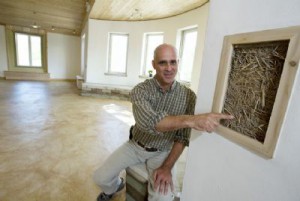Sustainable building a passion
Posted By ANDREA HOUSTON, EXAMINER EDUCATION WRITER thepeterboroughexaminer.com Photo courtesy of Clifford Skarstedt, ExaminerCAMP KAWARTHA ENVIRONMENT CENTRE: New facility at Trent University one of Canada’s most sustainable buildings

Camp Kawartha executive director Jacob Rodenburg tours the now finished Camp Kawartha Environment Centre on Pioneer Rd. yesterday. The building was built by students from Fleming College’s Sustainable Building Design and Construction Program. The facility will mainly be used to teach children of all ages about environmental living and renewable energy. The building has straw bale walls, a living roof, an indoor wetland water filtration system, Ontario’s only thatch roof, solar panels as the energy source and a geothermal heating and cooling system.
For Jacob Rodenburg, the Camp Kawartha Environment Centre is an example of what’s possible when the passion for a sustainable future is combined with the will to make it a reality.
Yesterday, Rodenburg, executive director of Camp Kawartha, gaveThe Examinera tour of the finished building on Pioneer Rd. at Trent University.
“I dream about a whole community built like this,” he said, fondly running his hand along a wall. “There’s no reason this can’t be done everywhere. The technology is there. We just have to adopt a different attitude.”
As one of Canada’s most sustainable buildings, it contains many innovative, experimental and unique features, Rodenburg said.
The facility will mainly be used to teach children of all ages about environmental living and renewable energy.
The building has straw bale walls, a living roof, an indoor wetland water filtration system, Ontario’s only thatch roof, solar panels as the energy source and a geothermal heating and cooling system.
“This whole building is zero emissions and all the materials were sourced as locally as we could find,” Rodenburg said.
The doors will open to the public in mid-October with a ribbon-cutting ceremony on Nov. 7, he said.
“I believe this can really showcase to people how we can live more gently,” he said. “Maybe they will be inspired to take elements of the building into future projects of their own.”
Chris Magwood, program coordinator for Fleming College’s sustainable building design and construction program, piloted the idea.
Magwood and his team of 26 student builders used several different sustainable building materials for the facility, including slip-straw, hempcrete, earthen blocks and reclaimed bricks.
“When you do a building like this, you are pushing the boundaries of construction,” Rodenburg said. “In a way, (Magwood) is a pioneer.”
The project took 20 weeks to complete, he said.
“The students added many creative and whimsical touches to the design, which you can see throughout,” Rodenburg said.
On one wall, green and blue jars, bottles and cans are set artistically into plaster, creating the shape of a tree that casts colourful splashes of light onto the surrounding walls.
“(The bottles) are reclaimed materials that would have gone into the landfill,” he said. “Instead it’s beautiful.”
Resembling fossils on the slag concrete floor are footprints of wildlife, such as a white-tailed deer, a red fox, a snake, a raccoon, a bear cub and a cotton-tailed rabbit.
“The students made all the animal tracks anatomically correct,” he noted.
In the centre of the floor is a perfect star compass, made of yellow limestone.
Each gable end — the top triangular part of the wall touching the roof — is insulated by using bits of old blue jeans, Rodenburg said.
Outside, foliage can be seen peeking up from the living green roof.
“Up there we’ve planted local indigenous plants, native species and we hope to have butterflies come,” he said. “A green roof creates extra habitat and it’s really well insulated.”
The wood on the ceiling inside is cedar from local sustainable forests, he said.
The centre also has a rainwater collection and treatment system, composting toilets and energy efficient lighting.
On posts behind the facility will be 42 solar panels to collect the sun’s rays, he said.
After powering the whole building, any energy not used will go back on the grid and the environment centre will be credited 80 cents for every kilowatt-hour produced, Rodenburg said.
“Over the course of the year we might earn $3,500 to $4,000,” he said. “So instead of a utility bill, we get credit for the electricity we produce.”
The building has the capacity to hold about 85 people at a time, he said.
Once open to the public, the main open-concept space will be filled with small interactive educational displays to illustrate how the sustainable features work.
“We will also have open houses for the community so they can come and visit,” he said.
There will be guided tours beginning in October from 4 to 6 p. m. every Friday, he said.
Once a month, sustainable workshops will be hosted in the facility featuring expert speakers and educators.
Young pupils will learn curriculum- based programs on sustainability, nature and the environment, he said. High school students will take a more science-based approach, learning about water quality, habitat suitability and renewable energy.
The 2,100-square foot centre cost about $200,000 to build.
The land for the facility was donated by Trent University, Rodenburg said. The Gainey Foundation donated $100,000 to the building.
“This project would not have been possible without our donors,” he said.
Also, the student labour works out to about a $200,000 value, he said.
But the work isn’t completely done yet, Rodenburg said. The next task is to make a parking lot in the front and get started on the outside landscaping.
NOTE: Find out more about the Camp Kawartha Environment Centre at www.sustainablebuilding2009.ca.
Environment Centre
Examples of educational programs at the Environment Centre:
- Alternative energy: Living beyond fossil fuels
- Habitat
- Water quality
- Climate change
- Air quality
- Your ecological footprint
- Sustainable building, sustainable living
- Species at risk
 Gainey Foundation
Gainey Foundation